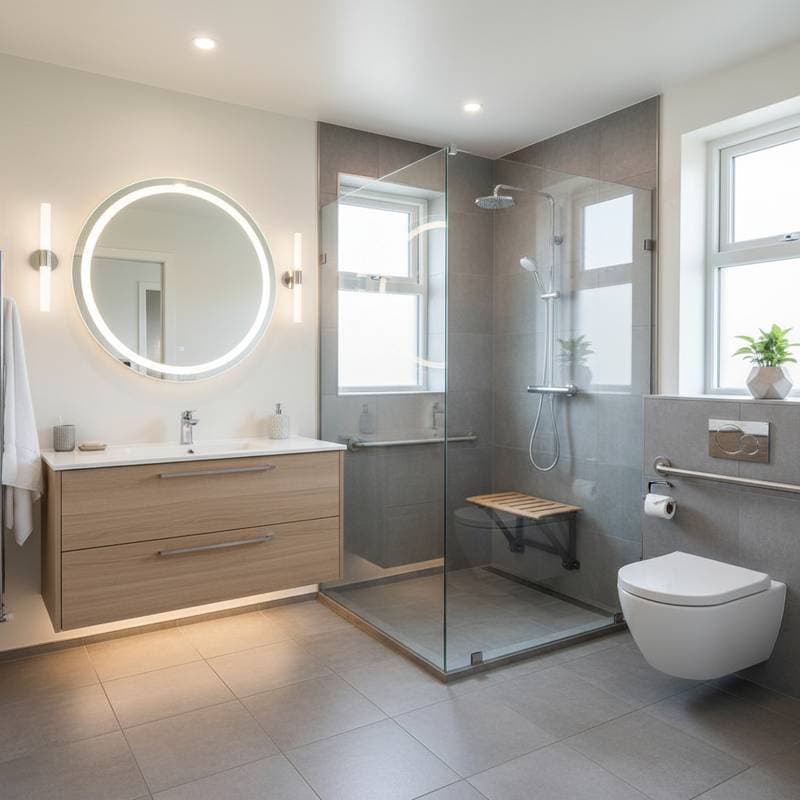Bathroom Features for Aging in Place: Designs That Support Lifelong Independence
Every home reflects the lives of its inhabitants. The bathroom stands out as a deeply personal space for daily routines of self-care and reflection. For individuals committed to aging in place, this room evolves into a sanctuary that upholds independence, safety, and dignity through changing years.
Effective bathroom design balances aesthetics with practicality. Universal design approaches create adaptable environments that anticipate future needs without compromising beauty. The aim extends beyond mere accessibility; it involves crafting spaces that empower users and integrate seamlessly into daily life.
This article outlines key bathroom features that facilitate lifelong independence. Each element combines practical benefits with elegant design, providing guidance for homeowners and designers alike.
1. Space Planning for Freedom of Movement
The layout forms the core of an accessible bathroom. Designers prioritize clear pathways with a minimum diameter of five feet to accommodate wheelchairs or walkers. Pocket doors or doors that swing outward minimize obstacles during emergencies.
Positioning the shower, toilet, and sink along a single wall streamlines plumbing while opening up floor space. This arrangement promotes ease of navigation for all users. The outcome delivers a spacious feel that enhances usability without reducing the room's appeal.
2. Curbless Showers for Seamless Access
Curbless showers eliminate barriers at the entry, allowing smooth transitions for mobility aids. These designs feature sloped floors that drain efficiently, often with linear drains to maintain a clean aesthetic. Materials like porcelain tiles in neutral tones ensure durability and a spa-like atmosphere.
Integrating a fold-down bench or built-in seating supports seated showering. Waterproof walls in textured finishes prevent slips inside the enclosure. Such features make the shower inclusive, benefiting families across generations while simplifying maintenance.
3. Grab Bars as Integrated Supports
Contemporary grab bars serve dual purposes, functioning as towel holders or shelves in stylish finishes like brushed nickel or matte black. Brands such as Moen offer collections that blend into the decor, avoiding a utilitarian look. Early incorporation during planning ensures they align with the overall design.
Strategic placement includes horizontal bars at shower thresholds, vertical ones near sinks, and angled supports by toilets. These provide reliable stability points. The result integrates safety into the space's visual harmony.
4. Slip-Resistant Flooring with Natural Textures
Flooring choices directly impact safety and comfort. Textured porcelain or natural stone tiles deliver superior traction alongside visual warmth. A sealed honed marble mosaic, for instance, offers a gentle surface that resists moisture and wear.
Incorporate subtle color contrasts, such as a floor tone slightly darker than the walls, to aid spatial awareness for those with reduced vision. Neutral palettes like soft grays or beiges from brands such as Sherwin-Williams create serene environments. These selections enhance both functionality and timeless style.
5. Adjustable-Height Vanities and Sinks
Versatile vanities adapt to user preferences, with wall-mounted models adjustable for seated or standing heights. Floating designs permit wheelchair clearance underneath, reducing visual clutter. Durable surfaces like quartz or solid composites withstand daily use and require minimal upkeep.
Matte finishes cut down on glare, benefiting users with sensitive vision. Pair these with lever faucets and under-cabinet illumination for intuitive operation. The setup maintains an inviting, non-institutional appearance.
6. Strategic Storage Solutions
Effective storage promotes independence by placing essentials within easy reach. Pull-out drawers equipped with soft-close hardware prevent strain, while open shelves at waist height store frequently used items. Recessed niches in shower walls keep toiletries accessible and organized.
Warm woods such as oak or walnut add a residential touch, with moisture-resistant finishes ensuring longevity. Designers like Studio McGee emphasize cabinetry that resembles freestanding furniture. This approach merges utility with charm, making the space feel lived-in and personal.
7. Layered Lighting for Visibility and Ambiance
Proper illumination addresses varying needs, from task lighting at mirrors to ambient glows for relaxation. Dimmable sconces and recessed ceiling fixtures provide adjustable brightness. Under-cabinet strips highlight countertops without harsh shadows.
Warm LED bulbs in 2700K range mimic natural light, reducing eye strain. Motion-sensor options activate automatically in low-visibility areas. These layers create a versatile atmosphere that supports daily tasks while elevating the room's elegance.
8. Smart Fixtures for Effortless Control
Technology enhances usability through touchless faucets and sensor-based flushing systems. These fixtures from brands like Kohler conserve water and minimize contact, ideal for hygiene-focused routines. Voice-activated mirrors with defogging capabilities display information clearly.
Integrated thermostats maintain consistent shower temperatures, preventing scalding risks. App-controlled elements allow remote adjustments for added convenience. Such innovations blend seamlessly, offering modern efficiency without overwhelming the design.
Integrating These Features into Your Bathroom
A bathroom built for aging in place thrives on thoughtful integration. Select elements that align with personal style, ensuring the space feels cohesive and welcoming. Professional consultation during planning maximizes benefits and avoids costly retrofits.
Homeowners often find these upgrades yield broader advantages. Curbless entries simplify cleaning, while smart controls promote sustainability. Layered lighting and accessible storage improve daily flow for all household members.
Ultimately, these designs honor the evolving needs of residents. They transform the bathroom into a resilient haven, celebrating independence and the beauty of enduring homes.









